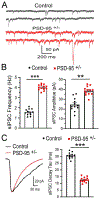PSD-95 deficiency alters GABAergic inhibition in the prefrontal cortex
- PMID: 32818520
- PMCID: PMC7572776
- DOI: 10.1016/j.neuropharm.2020.108277
PSD-95 deficiency alters GABAergic inhibition in the prefrontal cortex
Abstract
Postsynaptic Density Protein-95 (PSD-95) is a major scaffolding protein in the excitatory synapses in the brain and a critical regulator of synaptic maturation for NMDA and AMPA receptors. PSD-95 deficiency has been linked to cognitive and learning deficits implicated in neurodevelopmental disorders such as autism and schizophrenia. Previous studies have shown that PSD-95 deficiency causes a significant reduction in the excitatory response in the hippocampus. However, little is known about whether PSD-95 deficiency will affect gamma-aminobutyric acid (GABA)ergic inhibitory synapses. Using a PSD-95 transgenic mouse model (PSD-95+/-), we studied how PSD-95 deficiency affects GABAA receptor expression and function in the medial prefrontal cortex (mPFC) during adolescence. Our results showed a significant increase in the GABAA receptor subunit α1. Correspondingly, there are increases in the frequency and amplitude in spontaneous inhibitory postsynaptic currents (sIPSCs) in pyramidal neurons in the mPFC of PSD-95+/- mice, along with a significant increase in evoked IPSCs, leading to a dramatic shift in the excitatory-to-inhibitory balance in PSD-95 deficient mice. Furthermore, PSD-95 deficiency promotes inhibitory synapse function via upregulation and trafficking of NLGN2 and reduced GSK3β activity through tyr-216 phosphorylation. Our study provides novel insights on the effects of GABAergic transmission in the mPFC due to PSD-95 deficiency and its potential link with cognitive and learning deficits associated with neuropsychiatric disorders.
Keywords: GABA receptors; Inhibitory transmission; PSD-95; Prefrontal cortex; Schizophrenia.
Copyright © 2020 Elsevier Ltd. All rights reserved.
Conflict of interest statement
Conflict of Interests
The authors report no competing interests or biomedical financial interests.
Figures






References
-
- Akbarian S, 1995. GABAA receptor subunit gene expression in human prefrontal cortex: comparison of schizophrenics and controls. Cereb. Cortex 5, 550–560. - PubMed
Publication types
MeSH terms
Substances
Grants and funding
LinkOut - more resources
Full Text Sources
Molecular Biology Databases

